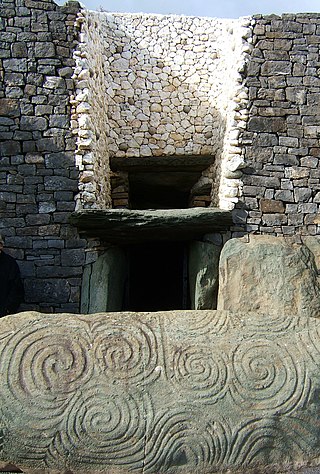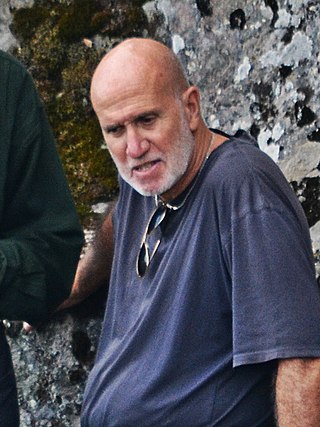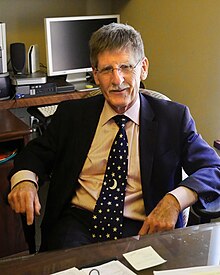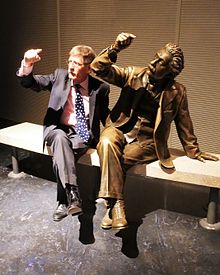
Archaeoastronomy is the interdisciplinary or multidisciplinary study of how people in the past "have understood the phenomena in the sky, how they used these phenomena and what role the sky played in their cultures". Clive Ruggles argues it is misleading to consider archaeoastronomy to be the study of ancient astronomy, as modern astronomy is a scientific discipline, while archaeoastronomy considers symbolically rich cultural interpretations of phenomena in the sky by other cultures. It is often twinned with ethnoastronomy, the anthropological study of skywatching in contemporary societies. Archaeoastronomy is also closely associated with historical astronomy, the use of historical records of heavenly events to answer astronomical problems and the history of astronomy, which uses written records to evaluate past astronomical practice.
George Ogden Abell was an American educator. Teaching at UCLA, priorly he worked as a research astronomer, administrator, as a popularizer of science and of education, and as a skeptic. He earned his B.S. in 1951, his M.S. in 1952 and his Ph.D. in 1957, all from the California Institute of Technology. He was a Ph.D. student under Donald Osterbrock. His astronomical career began as a tour guide at the Griffith Observatory in Los Angeles. Abell made great contributions to astronomical knowledge which resulted from his work during and after the National Geographic Society - Palomar Observatory Sky Survey, especially concerning clusters of galaxies and planetary nebulae. A galaxy, an asteroid, a periodic comet, and an observatory are all named in his honor. His teaching career extended beyond the campus of UCLA to the high school student oriented Summer Science Program, and educational television. He not only taught about science but also about what is not science. He was an originating member of the Committee on Scientific Investigation of Claims of the Paranormal now known as the Committee for Skeptical Inquiry.

The Astronomical Society of the Pacific (ASP) is an American scientific and educational organization, founded in San Francisco on February 7, 1889, immediately following the solar eclipse of January 1, 1889. Its name derives from its origins on the Pacific Coast, but today it has members all over the country and the world. It has the legal status of a nonprofit organization.

Griffith Observatory is an observatory in Los Angeles, California, on the south-facing slope of Mount Hollywood in Griffith Park. It commands a view of the Los Angeles Basin including Downtown Los Angeles to the southeast, Hollywood to the south, and the Pacific Ocean to the southwest. The observatory is a popular tourist attraction with a close view of the Hollywood Sign and an extensive array of space and science-related displays. It is named after its benefactor, Griffith J. Griffith. Admission has been free since the observatory's opening in 1935, in accordance with the benefactor's will.

Norman Sperling is an author, editor, publisher, teacher, and telescope designer living in San Mateo, California.

The Summer Science Program (SSP) is an academic summer program where high school students experience college-level education and do research in celestial mechanics by studying the orbits of asteroids, biochemistry by studying the kinetic properties of enzymes, or genomics by studying antibiotic resistance. The program was established in 1959 at The Thacher School in Ojai, California. It now takes place on three astrophysics campuses, New Mexico Tech in Socorro, New Mexico, the University of North Carolina at Chapel Hill in Chapel Hill, North Carolina, and University of Colorado, Boulder in Boulder, Colorado, and two biochemistry campuses, Purdue University in West Lafayette, Indiana and Indiana University Bloomington in Bloomington, Indiana.

Armagh Observatory is an astronomical research institute in Armagh, Northern Ireland. Around 25 astronomers are based at the observatory, studying stellar astrophysics, the Sun, Solar System astronomy and Earth's climate.

The Center for Astrophysics | Harvard & Smithsonian (CfA), previously known as the Harvard–Smithsonian Center for Astrophysics, is an astrophysics research institute jointly operated by the Harvard College Observatory and Smithsonian Astrophysical Observatory. Founded in 1973 and headquartered in Cambridge, Massachusetts, United States, the CfA leads a broad program of research in astronomy, astrophysics, Earth and space sciences, as well as science education. The CfA either leads or participates in the development and operations of more than fifteen ground- and space-based astronomical research observatories across the electromagnetic spectrum, including the forthcoming Giant Magellan Telescope (GMT) and the Chandra X-ray Observatory, one of NASA's Great Observatories.

Robert Bauval is an Egyptian writer and lecturer, perhaps best known for the fringe Orion Correlation Theory regarding the Giza pyramid complex.

Dinsmore Alter was an American astronomer, meteorologist, and United States Army officer. He is known for his work with the Griffith Observatory and his creation of a lunar atlas.

Philip Fox was an American astronomer and an officer in the U.S. Army. He was the first director of the Adler Planetarium in Chicago, the first planetarium in the western hemisphere.

The Norman Lockyer Observatory, the Lockyer Technology Centre, and the Planetarium, is a public access optical observatory 1 mile (1.6 km) east of Sidmouth, East Devon in South West England. It houses a number of historical optical telescopes, including the Lockyer Telescope, and is operated by Norman Lockyer Observatory Society (NLOS).
Laura Danly is an American astronomer and academic who served as Curator of the Griffith Observatory in Los Angeles. She has also served as chair of the Department of Space Sciences at the Denver Museum of Nature & Science.
Don Dixon is an American astronomical artist practicing space art in the tradition of Chesley Bonestell.
The Andrew Gemant Award is a prize awarded by the American Institute of Physics to a person who has made substantial cultural, artistic, or humanistic contributions to physics. The award is named after Andrew Gemant, a pioneer in materials science.
18117 Jonhodge (provisional designation 2000 NY23) is a bright background asteroid from the inner regions of the asteroid belt, approximately 3 kilometers in diameter. It was discovered on 5 July 2000, by astronomer of the Lowell Observatory Near-Earth Object Search at Anderson Mesa Station near Flagstaff, Arizona, in the United States. The asteroid was named after American teacher Jonathon Hodge.
Clive L. N. Ruggles is a British astronomer, archaeologist and academic. He is the author of academic and popular works on the subject. In 1999, he was appointed professor of archaeoastronomy at the School of Archaeology and Ancient History, University of Leicester, when it is believed to have been the only appointed chair for archaeoastronomy among the world's universities. As of 2023, he was Emeritus Professor at this university.
The RUM Planetarium is the first planetarium in Puerto Rico. It is located in the fourth floor of the Physics building of the University of Puerto Rico at Mayagüez in Mayagüez, Puerto Rico.
Ronald N. Hartman was a professor of astronomy and the director of the planetarium at Mt. San Antonio College in Walnut, California for 38 years. He was also well known in the community of meteorite collectors and hunters.
















